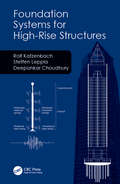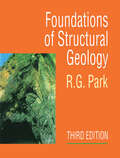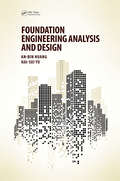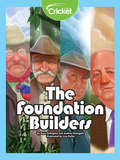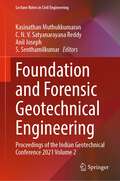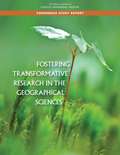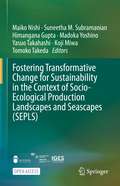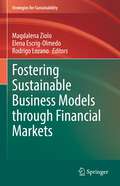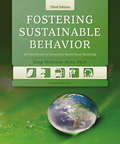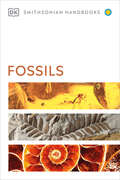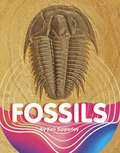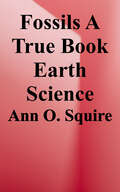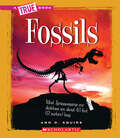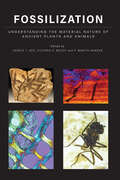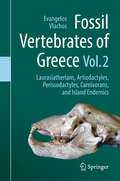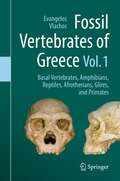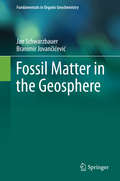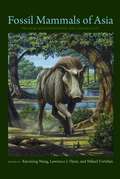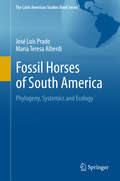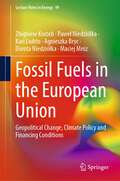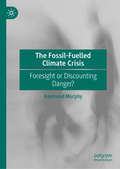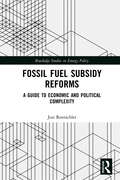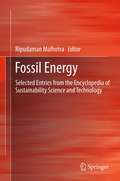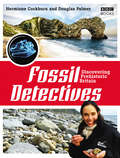- Table View
- List View
Foundation Systems for High-Rise Structures
by Rolf Katzenbach Steffen Leppla Deepankar ChoudhuryThe book deals with the geotechnical analysis and design of foundation systems for high-rise buildings and other complex structures with a distinctive soil-structure interaction. The basics of the analysis of stability and serviceability, necessary soil investigations, important technical regulations and quality and safety assurance are explained and possibilities for optimised foundation systems are given. Additionally, special aspects of foundation systems such as geothermal activated foundation systems and the reuse of existing foundations are described and illustrated by examples from engineering practice.
Foundation of Structural Geology
by R G ParkSince the first edition was published in 1983, this highly-regarded introductory textbook has been used by many generations of students worldwide. It is specifically tailored to the requirements of first or second year geology undergraduates.The third edition has been extensively revised and updated to include many new sections and over 50 new or redrawn illustrations. There are now over 220 illustrations, many incorporating a second colour to highlight essential features. The format has been changed to enhance the visual attractiveness of the book.The tripartite organization of the first and second editions has been modified by combining the purely descriptive or factual aspects of fault and fold structure in the earlier chapters with a simple treatment of mechanisms, leaving the more geometrically complex treatment until after the relevant sections on stress and strain, as before. Some subjects are introduced for the first time, e.g. inversion and orogen collapse, and others have been extensively modified, e.g. the chapter on gravity controlled structures now emphasises modern work on salt tectonics. The last third of the book is devoted to the wider context of geological structures and how they relate to plate tectonics. The final two chapters have been considerably expanded and give examples of various types of geological structures in their plate tectonic settings in both modern and ancient orogenic belts.
Foundation Engineering Analysis and Design
by An-Bin Huang Hai-Sui YuOne of the core roles of a practising geotechnical engineer is to analyse and design foundations. This textbook for advanced undergraduates and graduate students covers the analysis, design and construction of shallow and deep foundations and retaining structures as well as the stability analysis and mitigation of slopes. It progressively introduces critical state soil mechanics and plasticity theories such as plastic limit analysis and cavity expansion theories before leading into the theories of foundation, lateral earth pressure and slope stability analysis. On the engineering side, the book introduces construction and testing methods used in current practice. Throughout it emphasizes the connection between theory and practice. It prepares readers for the more sophisticated non-linear elastic-plastic analysis in foundation engineering which is commonly used in engineering practice, and serves too as a reference book for practising engineers. A companion website provides a series of Excel spreadsheet programs to cover all examples included in the book, and PowerPoint lecture slides and a solutions manual for lecturers. Using Excel, the relationships between the input parameters and the design and analysis results can be seen. Numerical values of complex equations can be calculated quickly. non-linearity and optimization can be brought in more easily to employ functioned numerical methods. And sophisticated methods can be seen in practice, such as p-y curve for laterally loaded piles and flexible retaining structures, and methods of slices for slope stability analysis.
The Foundation Builders
by Gina DeAngelisLearn about America's founding conservationists: Theodore Roosevelt, Gifford Pinchot, Stephen T. Mather, Hugh Hammond Bennett.
Foundation and Forensic Geotechnical Engineering: Proceedings of the Indian Geotechnical Conference 2021 Volume 2 (Lecture Notes in Civil Engineering #295)
by Kasinathan Muthukkumaran C. N. V. Satyanarayana Reddy Anil Joseph S. SenthamilkumarThis book comprises the select peer-reviewed proceedings of the Indian Geotechnical Conference (IGC) 2021. The contents focus on Geotechnics for Infrastructure Development and Innovative Applications. This book covers topics related to shallow foundations, pile & piled raft foundation, geotechnical design of foundation, wind turbine foundation, foundations on problematic soils, forensic geotechnical engineering, and case studies on geotechnical failures. This book is of interest to those in academia and industry.
Fostering Transformative Research in the Geographical Sciences
by National Academies of Sciences Engineering MedicineThe central purpose of all research is to create new knowledge. In the geographical sciences this is driven by a desire to create new knowledge about the relations between space, place, and the anthropogenic and non-anthropogenic features and processes of the Earth. But some research goes beyond these modest aims and creates new opportunities for further research, or affects the process of knowledge acquisition more broadly, or changes the way other researchers in a domain think about the world and go about their business. Due to its positive impacts, transformative research can be regarded as inherently having greater value than more conventional research, and funding agencies clearly regard transformative research as something to be encouraged and funded through special programs. Assessments of transformative research funding initiatives are few and provide a mixed picture of their effectiveness. The challenge is whether transformative research can be identified at the time it is proposed rather than after it has been conducted, communicated, and its influence on the discipline has become clear. Fostering Transformative Research in the Geographical Sciences reviews how transformative research has emerged in the past, what its early markers were, and makes recommendations for how it can be nurtured in the future.
Fostering Transformative Change for Sustainability in the Context of Socio-Ecological Production Landscapes and Seascapes (SEPLS)
by Maiko Nishi Suneetha M. Subramanian Himangana Gupta Madoka Yoshino Yasuo Takahashi Koji Miwa Tomoko TakedaThis open access book is a compilation of case studies that provide useful knowledge and lessons that derive from on-the-ground activities and contribute to policy recommendations, focusing on the relevance of social-ecological production landscapes and seascapes (SEPLS) to “transformative change.” The concept of “transformative change” has been gaining more attention to deal with today’s environmental and development problems, whereas both policy and scientific communities have been increasingly calling for transformative change toward sustainable society. The Intergovernmental Science-Policy Platform on Biodiversity and Ecosystem Services (IPBES) has planned to start the so-called “assessment on transformative change” if approved by the IPBES plenary to be held in 2021. At present, the idea of transformative change, including its scope, methodologies, approaches and strategies, are yet to be clarified. By bringing together all of the different concerns and interests in the land/seascape, SEPLS approaches could provide practical and experience-based insights for understanding and gauging transformative change and identifying determinants of such change. This book explores how SEPLS management relates to the idea of transformative change to further the discussion of sustainable transitions in advancing sustainability science. The introductory chapter is followed by case study chapters offering real-world examples of transformative change as well as a synthesis chapter clarifying the relevance of the case study findings to policy and academic discussions. It will be of interest to scholars, policymakers and professionals in the fields related to sustainable development.
Fostering Sustainable Business Models through Financial Markets (Strategies for Sustainability)
by Magdalena Ziolo Elena Escrig-Olmedo Rodrigo LozanoThe aim of this volume is to foster more sustainable business models through financial markets. To that end, it is necessary to know the main global challenges facing financial markets and their impact on creating sustainable value in business models of enterprises in the context of sustainable adaptation. The book focuses on assessing the decision criteria adopted by financial markets in the process of transaction risk valuation, in terms of the presence of Environmental, Social, and Governance (ESG) criteria, and by assessing the impact of including these criteria in the risk assessment process by financial markets in business decisions, leading as a consequence to building new value in the form of a sustainable business model. The book presents global ESG risks facing the financial markets, and discusses how ESG risks are managed and monitored, and how financial markets can measure and operationalize extra-financial risks in its assessment process. The book also analyses ESG risk implications and influences on company behavior, and the actions that companies should take considering the ESG assessment requirements of financial markets. Finally, it provides a comprehensive, structured, and systematic view of how financial markets and companies should adapt and improve their business models. The book provides unique challenges for investors, companies, financial markets, and for our society as a whole, advancing traditional risk management approaches to address global risks.
Fostering Sustainable Behavior
by Doug Mckenzie-MohrTo attain a sustainable future, we must change many of our everyday actions. This completely revised and updated edition of Fostering Sustainable Behavior shows how community-based social marketing is key to overcoming barriers and resistance, and creating new social norms.
Fossils Tell of Long Ago (Let's-Read-and-Find-Out Science 2)
by AlikiWhat is a fossil?Sometimes it's the imprint of an ancient leaf in a rock. Sometimes it's a woolly mammoth, frozen for thousands of years in the icy ground. Sometimes it's the skeleton of a stegosaurus that has turned to stone.A fossil is anything that has been preserved, one way or another, that tells about life on Earth. But you can make a fossil, too—something to be discovered a million years from now—and this book will tell you how.
Fossils (DK Handbooks)
by DKThe clearest and sharpest recognition guide to over 500 invertebrate, vertebrate, and plant fossils from around the world. This comprehensive pocket guide is the perfect introduction to finding, identifying, and collecting fossils. It features more than 500 species of plant and animal fossils, from trilobites and megafauna to dinosaurs and ancient trees. This handbook cuts through the complicated identification process with expertly written and thoroughly vetted text that features precise description, enabling you to recognize a species instantly. Over 1,000 photographs, with illuminating annotations, help you pick out a fossil's chief characteristics and distinguishing features, while a color illustration shows the fossil as a living plant or animal. The detailed introduction explains what a fossil is and how they are classified. Start building your own collection with advice on where to look for fossils, what tools and safety equipment are needed for collecting, and how best to organize a fossil collection. To help you in the initial stages of identification, this book provides a visual identification key that makes it easy to recognize a fossil and place it in its correct group. Finally, a concise glossary gives instant understanding of technical and scientific terms.
Fossils (Earth Materials and Systems)
by Keli SipperleyPlants and animals from millions of years ago left behind fossils. Fossils can teach people about the past. They are also used for fuel. Discover why fossils are an important part of nature!
Fossils (A True Book (relaunch): Earth Science Series)
by Ann O. SquireFossils are one of the most important tools we have for learning about long-extinct wildlife. A True Book: Earth Science series presents fascinating facts and fun activities that will engage the budding earth scientist, while exploring the fields of geology, meteorology, ecology, and more. <p><p>This series includes an age appropriate (grades 3-5) introduction to curriculum-relevant subjects and a robust resource section that encourages independent study. In the 4.6 billion years since Earth was formed, many plant and animal species have come and gone. Readers will discover how fossils are formed, how paleontologists search for them, and what kinds of information they can provide.
Fossils (A True Book (Relaunch))
by Ann O. SquireFossils are one of the most important tools we have for learning about long-extinct wildlife.A True Book: Earth Science series presents fascinating facts and fun activities that will engage the budding earth scientist, while exploring the fields of geology, meteorology, ecology, and more. This series includes an age appropriate (grades 3-5) introduction to curriculum-relevant subjects and a robust resource section that encourages independent study.In the 4.6 billion years since Earth was formed, many plant and animal species have come and gone. Readers will discover how fossils are formed, how paleontologists search for them, and what kinds of information they can provide.
Fossilization: Understanding the Material Nature of Ancient Plants and Animals
by Carole T. Gee, Victoria E. McCoy, and P. Martin SanderAn in-depth look at the latest breakthroughs in our understanding of the material record that deep time leaves behind.Understanding the complex interplay of physical and chemical processes leading to fossilization is crucial to elucidating the 3800 million years of life on earth. And yet, the process of fossilization also leads to the loss of pivotal biological information, placing constraints on the very same understanding of ancient life it preserves. Over the last decade, however, remarkable advances in approaches, techniques, tools, and instrumentation have helped scientists to transcend these constraints by enabling high-resolution analysis of fossil material—even down to the nanoscale. Fossilization provides a critical look at these cutting-edge innovations in the science of fossil preservation and provides a road map for future research. Drawing from the fields of paleontology, organic and inorganic chemistry, microbiology, and high-resolution imaging and analysis, and spanning the diversity of life from plants to vertebrates and invertebrates, this resource details expert findings on• fossilization of hard and soft part tissues in dinosaurs• high-resolution chemical analysis of organic and inorganic tissues• arthropods preserved in amber• experimental silicification of wood• chemical defenses and color in fossil plants • confocal Raman spectroscopy• microprobe analysis• radioisotopic studies• and much moreA true interdisciplinary undertaking, the book is authored by paleontologists, mineralogists, geochemists, organic chemists, microbiologists, and materials scientists who have worked together to investigate questions around substance fossilization and the limits of the fossil record. A special color section contains SEM, Raman, and other striking images of vertebrates, invertebrates, and plants. Fossilization is a trailblazing reference book for research scientists and specialists in related fields, as well as for advanced undergraduates and graduate students interested in fossilization, emerging research techniques, and fresh approaches in the analysis of plant and animal fossils.Contributors: H. Jonas Barthel, Aurore Canoville, Carole T. Gee, Thorsten Geisler, Jens Götze, Conrad C. Labandeira, Sashima Läbe, Moritz Liesegang, Victoria E. McCoy, Martina Menneken, Jes Rust, P. Martin Sander, Frank Tomaschek, Torsten Wappler, Kayleigh Wiersma, Tzu-Ruei Yang
Fossil Vertebrates of Greece Vol. 2: Laurasiatherians, Artiodactyles, Perissodactyles, Carnivorans, and Island Endemics
by Evangelos VlachosThis 2-volume set provides a state-of-the-art study of the fossil record and taxonomy of the main vertebrate groups from Greece. Greece stands between 3 continents and its vertebrate fossil record is of great importance for paleontological and evolutionary studies in Europe, Asia and Africa. Fossils from classic, world-famous localities (e.g., Pikermi, Samos) form an essential part of the collections of the most important museums in the world and have been studied by numerous scientists. Recent paleontological research led to the discovery and study of numerous new sites. The volumes contain a taxonomic review of all named and identified taxa, their taxonomic history and current status, as well as historical, phylogenetic and biogeographic information. Volume 2 contains a synopsis of the fossil record and taxonomy of important groups of mammals represented in the fossil record of Greece. The volume starts with specific chapters on laurasiatherians like insectivores and bats, moving on to the main part of the book that deals with three of the most important fossil groups in the country. The fossil record of even-toed animals is summarized with chapters on bovids, cervids, suoids, anthracotheres, hippos, giraffes, and tragulids. The fossil record of odd-toed animals is presented with special chapters on horses, tapirs, rhinos, and chalicotheres. The last part of this volume deals with meat-eating, carnivoran groups, like felids, viverrids, hyaenas, canids, bears, ailurids, mephitids and mustelids. The volume ends with a special chapter on insular endemic mammals from the various islands of Greece.
Fossil Vertebrates of Greece Vol. 1: Basal vertebrates, Amphibians, Reptiles, Afrotherians, Glires, and Primates
by Evangelos VlachosThis 2-volume set provides a state-of-the-art study of the fossil record and taxonomy of the main vertebrate groups from Greece. Greece stands between 3 continents and its vertebrate fossil record is of great importance for paleontological and evolutionary studies in Europe, Asia and Africa. Fossils from classic, world-famous localities (e.g., Pikermi, Samos) form an essential part of the collections of the most important museums in the world and have been studied by numerous scientists. Recent paleontological research led to the discovery and study of numerous new sites. The volumes contain a taxonomic review of all named and identified taxa, their taxonomic history and current status, as well as historical, phylogenetic and biogeographic information. Volume 1 contains a synopsis of the fossil record and taxonomy of important groups of vertebrates represented in the fossil record of Greece. The volume deals with some of the early splitting clades, including the basal and enigmatic conodonts and basal tetrapods like fishes, amphibians, and reptiles like lizards, snakes, crocodiles, turtles and tortoises. The second part of the volume deals with basal mammalian clades, some of which are quite characteristic for the fossil record of the country: aardwarks, hyraxes, proboscideans, elephants and mammoths, sea cows, rodents, and lagomorphs. The volume ends with special chapters on the primate fossil record of the country, including some of our most recent and distant relatives.
Fossil Matter in the Geosphere
by Jan Schwarzbauer Branimir JovančićevićThe first volume in this new text book series covers comprehensively relevant aspects related to the appearance and characterisation of fossil matter in the geosphere such as kerogen, oil, shales and coals. As organic geochemistry is a modern scientific subject characterized by a high transdisciplinarity and located at the edge of chemistry, environmental sciences, geology and biology, there clearly is a need for a flexible offer of appropriate academic teaching material on an undergraduat level addressed to the variety of students coming originally from different study disciplines. For such a flexible usage this textbook series' consists of different volumes with clear defined aspects and with manageable length.
Fossil Mammals of Asia: Neogene Biostratigraphy and Chronology
by Lawrence J. Flynn Mikael Fortelius Xiaoming WangFossil Mammals of Asia, edited by and with contributions from world-renowned scholars, is the first major work devoted to the late Cenozoic (Neogene) mammalian biostratigraphy and geochronology of Asia. This volume employs cutting-edge biostratigraphic and geochemical dating methods to map the emergence of mammals across the continent. Written by specialists working in a variety of Asian regions, it uses data from many basins with spectacular fossil records to establish a groundbreaking geochronological framework for the evolution of land mammals. Asia s violent tectonic history has resulted in some of the world s most varied topography, and its high mountain ranges and intense monsoon climates have spawned widely diverse environments over time. These geologic conditions profoundly influenced the evolution of Asian mammals and their migration into Europe, Africa, and North America. Focusing on amazing new fossil finds that have redefined Asia s role in mammalian evolution, this volume synthe sizes information from a range of field studies on Asian mammals and biostratigraphy, helping to trace the histories and movements of extinct and extant mammals from various major groups and all northern continents, and providing geologists with a richer understanding of a variety of Asian terrains.
Fossil Horses of South America
by José Luis Prado María Teresa AlberdiThis book provides an update on the phylogeny, systematics and ecology of horses in South America based on data provided over the past three decades. The contemporary South American mammalian communities were shaped by the emergence of the Isthmus of Panama and by the profound climatic oscillations during the Pleistocene. Horses were a conspicuous group of immigrant mammals from North America that arrived in South America during the Pleistocene. This group is represented by 2 genera, Hippidion and Equus, which include small species (Hippidion devillei, H. saldiasi, E. andium and E. insulatus) and large forms (Equus neogeus and H. principale). Both groups arrived in South America via 2 different routes. One model designed to explain this migration indicates that the small forms used the Andes corridor, while larger horses used the eastern route and arrived through some coastal areas. Molecular dating (ancient DNA) suggests that the South American horses separated from the North American taxa (caballines and the New World stilt-legged horse) after 3.6 - 3.2 Ma, consistent with the final formation of the Panamanian Isthmus. Recent studies of stable isotopes in these horses indicate an extensive range of 13C values cover closed woodlands to C4 grasslands. This plasticity agrees with the hypothesis that generalist species and open biome specialist species from North America indicate a positive migration through South America.
Fossil Fuels in the European Union: Geopolitical Change, Climate Policy and Financing Conditions (Lecture Notes in Energy #99)
by Zbigniew Korzeb Paweł Niedziółka Kari Liuhto Agnieszka Bryc Dorota Niedziółka Maciej MrózThis book identifies scenarios for changes in transmission infrastructure, contracting, consumption patterns and fossil fuel financing policies, considering climate goals and the consequences of the conflict in Ukraine. The invasion of Ukraine by the Russian Federation has fundamentally changed the geopolitical situation, approaches to energy security issues, the EU’s energy (in)dependence and the implementation of previously outlined climate policies, including the planned gradual withdrawal from fossil fuels.This book presents the geopolitical architecture, energy mix, energy fuel supply structure, long-term energy policy and financing conditions of the oil and gas and sectors in the EU in the period preceding and following the Russian invasion of Ukraine. The authors consider the date of Russia’s attack on Ukraine as a symbolic caesura marking the beginning of the process of creating a new energy order in the EU. A novel part of the book is the attention it pays to the role of the credit and investment policy of the EU banking sector in relation to carbon-intensive sectors and to the significance of the financial system from the point of view of the effectiveness of international sanctions imposed on the Russian Federation, including, above all, sanctions related to the fossil fuel sector. The book is of interest to researchers and all those interested in learning about these subjects.
The Fossil-Fuelled Climate Crisis: Foresight or Discounting Danger?
by Raymond MurphyThis book analyses the threat posed by the continued use of fossil fuels. By utilizing Elizabeth Shove’s social practices approach and Murphy’s own social closure framework, the book examines the accelerating treadmill of carbon-polluting practices. It incorporates externalities theory to investigate how the full cost of fossil fuels is paid by others rather than users, and to demonstrate that the environmental commons is a medium for conveying intergenerational monopolisation and exclusion in the Anthropocene. Murphy uncovers a pattern of opposition to change when exploiting valuable but dangerous resources. He argues that a new faith in mastering nature is emerging as a belief in just-in-time technological solutions to circumvent having to change fossil-fuelled practices.The book then moves on to assess proposed solutions, including Beck’s staging of risk and his hypothesis that the anticipation of global catastrophe will incite emancipation. It proposes a novel approach to enhancing foresight and avoid incubating disaster. It will appeal to readers interested in an original social science analysis of this creeping crisis and its resolution.
Fossil Fuel Subsidy Reforms: A Guide to Economic and Political Complexity (Routledge Studies in Energy Policy)
by Jun RentschlerCountries around the world are spending up to $500 billion per year on subsidising fossil fuel consumption. By some estimates, the G20 countries alone are spending around another $450 billion on subsidising fossil fuel production. In addition, the indirect social welfare costs of these subsidies have been shown to be substantial – for instance due to air pollution, road congestion, climate change, and economic inefficiency, to name a few. Considering these numbers, there is no doubt that fossil fuel subsidies cause severe economic distortions that compromise countries’ prospects of achieving equitable and sustainable development. This book provides a guide to the complex challenge of designing, assessing, and implementing effective fossil fuel subsidy reforms. It shows that subsidy reform requires a careful balancing of complex economic and political trade-offs, as well as measures to mitigate adverse effects on vulnerable households and to assist firms with implementing efficiency enhancing measures. Going beyond the purely fiscal perspective, this book emphasises that smart subsidy reforms can contribute to all three dimensions of sustainable development – environment, society, and economy. Over the course of eight chapters, this book considers a wide range of agents and stakeholders, markets, and policy measures in order to distil the key principles of designing effective fossil fuel subsidy reforms. This book will be of great relevance to scholars and policy makers with an interest in energy economics and policy, climate change policy, and sustainable development more broadly.
Fossil Energy
by Ripudaman MalhotraThe word sustainability shares its root with sustenance. In the context of modern society, sustenance is inextricably linked to the use of energy. Fossil Energy provides an authoritative reference on all aspects of this key resource, which currently represents nearly 85% of global energy consumption. Gathering 16 peer-reviewed entries from the Encyclopedia of Sustainability Science and Technology, the chapters provide comprehensive, yet concise coverage of fundamentals and current areas of research. Written by recognized authorities in the field, this volume represents an essential resource for scientists and engineers working on the development of energy resources, fossil or alternative, and reflects the essential role of energy supplies in supporting a sustainable future.
The Fossil Detectives: Discovering Prehistoric Britain
by Douglas Palmer Hermione CockburnFossils provide us with a tantalizing glimpse of Britain's prehistoric past and hold the key to unlocking the secrets of life's history and evolution. Since the appearance of primitive organisms in Britain more than a billion years ago, oceans, deserts, swamps and vast mountains have come and gone in our corner of western Europe; forests of long-extinct trees, flowers and grasses have covered the land, and dinosaurs and other strange creatures have roamed across it. How do we know? The evidence is all around us - in the rocks and fossils that lie beneath the landscape.In this highly informative and practical book, which accompanies the BBC series, presenter Hermione Cockburn and renowned palaeontologist Douglas Palmer take an in-depth look at the most exciting fossil stories from around the country. When and why were dinosaur fossils first discovered in Britain? How was the biggest fish ever to have swum in the sea unearthed near Peterborough? What do modern medical techniques have to offer fossil hunters?Packed with colour photographs and illustrations, Fossils Detectives is full of surprising facts and features. And for those who want to try their hand at some fossil detecting of their own, the book includes an extensive regional gazetteer of fossil-hunting sites and places to visit, and guidance on identifying your fossil finds.Get ready for some time travel around Britain, with the Fossil Detectives!
